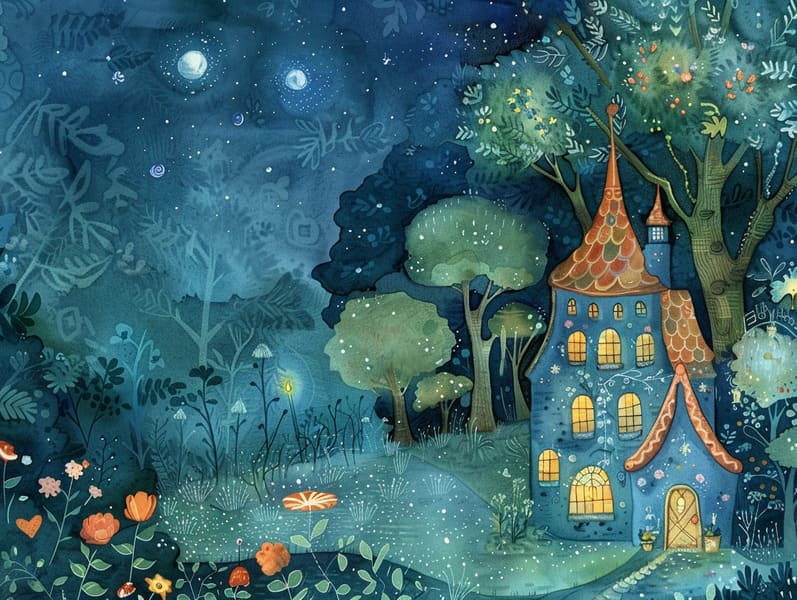
Famous fairy tales have old origins. These narratives have been passed down from one generation to the next centuries before they were ever written down. They came from a variety of civilizations, including Eastern traditions. They were initially passed along among older generations, often carrying themes and messages relevant to the societal norms and beliefs of the time.
Jacob and Wilhelm Grimm, Jacob and Wilhelm Grimm, were among the first to assemble many of these beloved fairy tales. Their collection, "Grimm's Fairy Tales," included stories like "Cinder Maid," "Hansel and Gretel," and "Snow-White and Rose-Red," which have since become mainstays in the world of classic fairy tales. Similarly, the Danish author's delightful tales, such as "The Sea Maid," and "The Duckling that Could," have gained the love worldwide, guaranteeing their place in the pantheon of iconic fairy tales.
Despite their historical roots, traditional fairy tales remain as impactful as ever, especially as bedtime stories for kids. These charming stories are now available in various formats, including beautifully illustrated books, magical animations, and web-based fairy tales.
Their enduring popularity can be connected to several enchanting factors:
Ethical Lessons: Traditional fairy tales often present important moral lessons. Narratives like "The Shepherd Boy and the Wolf" teach the value of sincerity, while "The Hare and the Tortoise" underline the qualities of determination and humility. These narratives offer kids clear distinctions between truth and falsehood, building their moral compass in a soft yet important way.
Warmth and Understanding: Fairy tales frequently depict personalities facing difficulties and adversities, inciting young readers to feel with their struggles and celebrate their triumphs. For instance, "The Tale of Beauty and the Beast" highlights the benefit of looking beyond appearances to perceive the true nature of a soul, strengthening perception and comprehension.
Cultural Perception: Many ancient fairy tales are steeped in the cultural contexts from which they developed. Discovering these fairy tales can provide illuminating insights into different ways of life, building a sense of international awareness and acknowledgment.
Imagination and Creativity: The imaginative elements in classic fairy tales—magical spells—unleash children’s fantastical thinking. These fairy tales carry readers to fantastical realms, provoking innovative thinking and a sense of delight that lasts a lifetime.
Old fairy tales are not only bewitching but also instructive. They work as bewitching tools in enhancing various cognitive and emotional skills in young ones. When classic fairy tales are voiced, they develop language development by introducing new terms and meanings and complicated sentence structures. This practice also boosts listening abilities and mindfulness, as kids concentrate deeply, anticipating to see what happens next.
Furthermore, talking about the themes and characters of fairy tales can strengthen cognitive skills and critical thinking. Kids are educated to pinpoint patterns, expect results, and get cause and effect. These contemplations also ease young readers utter their thoughts and feelings, adding to their emotional intelligence.
In today’s online age, the presence of internet fairy tales has made these narratives more accessible than ever. Websites and digital apps offer large libraries of famous fairy tales that can be explored or heard anytime, anywhere. Fairy tales spoken are particularly well-received, providing an entertaining method for little ones to relish these delightful tales. Voice books and read-out-loud stories lead characters and settings to life, often supported by charming audio effects and songs that improve the storytelling experience.
The timeless fascination of ancient fairy tales lies in their ability to adjust to new eras while staying true to their basic principles. Contemporary renditions of these tales often feature more multicultural characters and modern settings, making them understandable to today’s audience. However, the fundamental themes of valour, kindheartedness, and honesty remain unchanged, continuing to resonate with young listeners of all ages.
Timeless fairy tales also website offer a sense of solace and homeliness. They confer upon a well-ordered narrative with a transparent beginning, middle, and end, often coming to a close with the settlement of conflicts and the triumph of virtue over wickedness. This constancy can be reassuring for young ones, furnishing a sense of unwaveringness in an fluid world.
Timeless fairy tales continue to enthrall and guide new generations, maintaining their magic and pertinence in modern society. As nighttime stories for kids, they present to a perfect blend of captivation and insight, nurturing moral values, empathy, and creativity. The proliferation of web-based fairy tales and the prevalence of fairy tales voiced promise that these timeless tales remain reachable to new generations.
By sustaining and communicating these fairy tales, we continue to appreciate the rich tapestry of lore and cultural heritage. Whether you are reading a vividly illustrated book, enjoying a web-based collection, or listening on an audio story, the enchantment of Grimm's fairy tales is always within reach. These tales highlight of the everlasting effect of fairy tales and its ability to unite us across epochs and places.
Even if you are accessing a beautifully illustrated book, experiencing a electronic library, or playing an narrated book, the captivation of Grimm's fairy tales is always within reach.
These narratives demonstrate of the persistent impact of narratives and its ability to gather us across centuries and lands, forging a link that fascinates and enlightens alike.
Comments on “Uncovering the Past of Children's Fairy Tales and Their Enduring Radiance.”